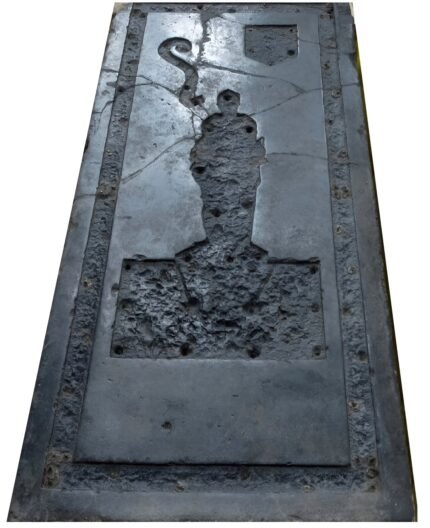The oldest known gravestone in the United States originated in Belgium, a new study finds, with tiny amoeba fossils in the stone pointing the researchers in the direction. The black limestone slab marks the grave of a knight who died in 1627 in Jamestown, Virginia, the first permanent English settlement in America.
This massive carved black limestone panel originally sat in the floor of Jamestown’s Second Church, built in 1617. When the church was rebuilt in the 1640s, it was moved to the south entrance area and its original location was destroyed. It was rediscovered in 1901 and moved to the new church, which was built in 1906.
There are depressions on the tombstone where brass ornaments were originally set. Historians believe that these brass ornaments may have been removed or destroyed when the church was burned during Bacon’s Rebellion in 1676. The shape of the depressions makes it clear what these brass ornaments were: a shield (probably a family crest) in the upper right, a scroll opposite, and a man holding a sword and shield in the center, standing on a rectangular pedestal, which may have been engraved with a funerary inscription. This armed figure marks the deceased as a knight.
Historians have found only two knights who died in Jamestown in the 17th century, and have narrowed the possibility of the tomb to either Sir Thomas West, the colony’s first resident governor (d. 1618), or his successor, Sir George Yeardley (d. 1627). There is nothing in the historical record to suggest that the former could have been the deceased. But there is strong evidence that the latter was the deceased. In his will in the 1680s, Sir George’s step-grandson, Adam Thorogood II, requested a black “marble” tombstone with Sir George Yeardley’s coat of arms and the same inscription as on the “broken grave,” indicating that it had been damaged in the 17th century.
 Black limestone, with its fine texture and ability to be polished to a high sheen, was the material of choice for tombstones of wealthy colonists on the Chesapeake Bay in the 17th century. It is often referred to as “marble” due to its polish and fine, uniform composition, but in this case, it is not marble that is key to determining its origin. The research term uses fossils trapped in the limestone to trace its origin, and microfossils that would normally be destroyed by the heat and pressure that forms marble are preserved in the limestone.
Black limestone, with its fine texture and ability to be polished to a high sheen, was the material of choice for tombstones of wealthy colonists on the Chesapeake Bay in the 17th century. It is often referred to as “marble” due to its polish and fine, uniform composition, but in this case, it is not marble that is key to determining its origin. The research term uses fossils trapped in the limestone to trace its origin, and microfossils that would normally be destroyed by the heat and pressure that forms marble are preserved in the limestone.
The researchers identified the microfossils in two fragments taken from the base of the tombstone. The limestone fragments, which were less than one centimeter square and half a centimeter thick, were sliced into thin sections and photographed in high resolution. The photos were then sent to experts to identify the microfossils.
Six species of single-celled amoeba fossils have been identified: Endocystis sp., Umbilicus Minimum, Umbilicus sp., Endotheliella globosum sp., Pseudoarchaeotaand P. Concave and convexThe results showed that the source rock came from Europe, specifically Ireland or Belgium, and could not have come from anywhere in North America. Two other black limestone tombstone fragments from the cemetery outside Jamestown Memorial Church, one from 1697 and one from 1713, were also cut and found to be from Belgium.
Historical evidence suggests Belgium as the likely source, as it has been the most common source of Lower Carboniferous “black” marble for centuries, from Roman times to the present day. During Yardley’s lifetime, this marble was particularly popular among the wealthy in Britain.
He and other Virginia colonists must have been well aware of the latest fashions in England and probably tried to copy them in the colonies.
The study has been published in International Journal of Historical Archaeology You can read the full article here.


 Anal Beads
Anal Beads Anal Vibrators
Anal Vibrators Butt Plugs
Butt Plugs Prostate Massagers
Prostate Massagers
 Alien Dildos
Alien Dildos Realistic Dildos
Realistic Dildos
 Kegel Exercisers & Balls
Kegel Exercisers & Balls Classic Vibrating Eggs
Classic Vibrating Eggs Remote Vibrating Eggs
Remote Vibrating Eggs Vibrating Bullets
Vibrating Bullets
 Bullet Vibrators
Bullet Vibrators Classic Vibrators
Classic Vibrators Clitoral Vibrators
Clitoral Vibrators G-Spot Vibrators
G-Spot Vibrators Massage Wand Vibrators
Massage Wand Vibrators Rabbit Vibrators
Rabbit Vibrators Remote Vibrators
Remote Vibrators
 Pocket Stroker & Pussy Masturbators
Pocket Stroker & Pussy Masturbators Vibrating Masturbators
Vibrating Masturbators
 Cock Rings
Cock Rings Penis Pumps
Penis Pumps
 Wearable Vibrators
Wearable Vibrators Blindfolds, Masks & Gags
Blindfolds, Masks & Gags Bondage Kits
Bondage Kits Bondage Wear & Fetish Clothing
Bondage Wear & Fetish Clothing Restraints & Handcuffs
Restraints & Handcuffs Sex Swings
Sex Swings Ticklers, Paddles & Whips
Ticklers, Paddles & Whips

















